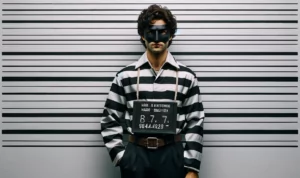By Miguel Fernandes Ceia

✅ AI Essay Writer ✅ AI Detector ✅ Plagchecker ✅ Paraphraser
✅ Summarizer ✅ Citation Generator
Even before Kurt Vonnegut’s 1969 novel has begun, the reader is already confronted on the back cover with a wide variety of themes and possibilities, the bombing of Dresden, alien abductions, and public displays of sex and time-travelling, that, from then onward, will be explored. These do not necessarily relate to each other or cohere in the same reality. In a sense, the reader will be expecting the unexpected.
Chapter 1 begins with the exposition of how Slaughterhouse-5 came to be. In an autobiographical tone, Kurt Vonnegut describes the predicament of writing a novel about his experience in the bombing of Dresden. He also takes the time to comment on his own craft as a writer, ‘a trafficker in climaxes and thrills and characterizations and wonderful dialogue and suspense and confrontations’, which leads the reader to believe that though this may be rooted in his own experience, the writer also has to transform this into a commercial product, therefore some aspects have to be fictionalised.
It would not be totally absurd to be talking about a fictional memoir. Like expecting the unexpected, this concept is a paradox, but it makes sense to talk about it in relation to this novel and the way Kurt Vonnegut sets the tone in the first chapter, oscillating between what is real, his factual presence in the bombing of Dresden, and what is not, Billy Pilgrim, a character who is abducted by aliens and is able to time-travel. This relation is the balance between a memoir, of how Kurt Vonnegut’s war experience is brought into a novel, and the use of fictional characters to mediate it. So, the first question the reader will have when starting to read Slaughterhouse-5 is, what is real and what is fiction? This choice is the first of many that will determine how the reader perceives this novel. Alternatively, the reader can choose not to choose and linger in doubt.
We would also like to make a note of the main character’s surname, Pilgrim: it should be understood as someone who is taking or will take a pilgrimage, a quest or journey in search of significance: in Billy Pilgrim’s case will be the understanding of life, death, time, fate, and free will. Already we find that in the main character’s name Kurt Vonnegut is hinting what is going to happen next, and though this may not be clear when confronted with the name Billy Pilgrim, as the novel progresses, the suggestion of magic, friendship, and pilgrimage in relation to the main character starts looming in the reader’s mind.
The fantastic is deeply related with the subject of this essay, the negotiation between the expected and the unexpected in Slaughterhouse-5. According to Tzvetan Todorov, ‘the fantastic implies (…) not only the existence of an uncanny event, which provokes a hesitation in the reader and the hero; but also a kind of reading (…) it must be neither “poetic” nor “allegorical”’ (Todorov, 1975: 32). In other words, the fantastic deals with an event which must not be understood as metaphorical, that will make the reader and the hero doubt its existence. In the case of Slaughterhouse-5, the uncanny events are the time-travelling and the alien abduction; the hero is not necessarily in doubt, but everyone around him, such as his daughter. And, of course, the reader, because he or she is offered a possible explanation for the uncanny events.
There are two explanations offered for Billy Pilgrim’s behaviour, which will give origin to the doubt or uncertainty regarding his claims. The first concerns his experience in the war and can be understood and post-traumatic stress, ‘he was treated in a veteran’s hospital near Lake Placid, and was given shock treatments and then released’; the second concerns a plane crash from which he was the only survivor. Both these events cast the shadow of the doubt over the reader and all the other characters with whom Billy Pilgrim shares his experience as time-traveller and as Tralfamadorian hostage.
Much of the reader’s doubt and expectation’s arise from the reality set by the writer, as Sigmund Freud illustrates,
If he [the writer] chooses, for instance, to set the action in a world in which spirits, demons and ghosts play a part, as Shakespeare does in Hamlet, Macbeth and Julius Caesar and, rather differently, in The Tempest and A Midsummer Night’s Dream, we must yield to his choice and treat his posited world as if it were real for as long as we submit to his spell (Freud, 2003: 139).
Kurt Vonnegut has chosen to set Slaughterhouse-5 in our world, a world where the bombing of Dresden really has happened. In a first instance, the reality of the reader is the reality of the characters. However, when time-travelling and alien abductions are brought into play, a new reality is offered, one that considers these events. Here the reader faces two possible worlds with different rules. But even so, claims of time-travelling and alien abduction are made by a man whom the reader is not sure to possess all his intellectual faculties. This predicament, which jumps from the characters surrounding Billy Pilgrim to the reader, upholds Tzvetan Todorov’s statement, that the fantastic genre has to ‘provoke an hesitation’; the doubt, the uncertainty, the hesitation that the reader has in relation with Billy Pilgrim’s claims are also directly related with the rules of the world set by Kurt Vonnegut. Tzvetan Todorov deals with the doubt, the hesitation and uncertainty in the following way,
In a world which is indeed our world, the one we know, a world without devils, sylphides, or vampires, there occurs an event which cannot be explained by the laws of this same familiar world. The person who experiences the event must opt for one of two possible solutions: either he is the victim of an illusion of the senses, of a product of imagination (…) or else the event has indeed taken place, it is an integral part of reality (Todorov, 1975: 25).
The hesitation is, undoubtedly, condition sine qua non for the fantastic genre in a narrative implying the integration ‘of the reader into the world of the characters; the world is defined by the reader’s own ambiguous perception of the events narrated’ (Todorov, 1975: 31). The reader can either choose not to believe Billy Pilgrim and set for the possible explanations offered; or the reader can believe in Billy Pilgrim and the rules of his world will include time-travelling and alien abductions. It is the doubt and the constant twisting of the reader’s expectations that relate the fantastic genre with the subject of this essay. According to Tzvetan Todorov, ‘the fantastic occupies the duration of this uncertainty’ (Todorov, 1975: 25).
Given the conditions offered by fiction where there are no limits, where one is allowed to write anything, everything—quality is a subsequent judgement—the writer can perpetuate the effects of the uncanny and the fantastic as long as he wants (or can). Kurt Vonnegut skilfully sustains them throughout Slaughterhouse-5, never allowing one possibility to overcome the other, thus emphasising the role of the reader in this choice. Sigmund Freud corroborates Tzvetan Todorov’s ideas in the following,
The writer can intensify and multiply this [uncanny] effect far beyond what is feasible in normal experience; in his stories he can make things happen that one would never, or only rarely, experience in real life. In a sense, then, he betrays us to a superstition we thought we had ‘surmounted’; he tricks us by promising us everyday reality and then going beyond it (…) fiction affords possibilities for a sense of the uncanny that would not be available in real life (Freud, 2003: 157).
So far, we have been pointing out only one of the conditions required for the fantastic genre. There are at least two more that Tzvetan Todorov has identified in his essay regarding the subject. He points three necessary conditions for the fantastic,
First, the text must oblige the reader to consider the world of the characters as a world of living persons and to hesitate between a natural and supernatural explanation of the evens described. Second, this hesitation may also be experienced by a character; thus the reader’s role is so to speak entrusted to a character, and at the same time the hesitation is represented, it becomes one of the themes of the work—in the case of the naïve reading, the actual reader identifies himself with the character. Third, the reader must adopt a certain attitude with regard to the text: he will reject allegorical as well as “poetic” interpretations (Todorov, 1975: 33).
The first two conditions are easily satisfied by Slaughterhouse-5, we have mentioned them earlier in this text. To satisfy the first condition, the reader faces the possibility that the main character may be suffering from post-traumatic stress or is still suffering the effects from a severe head injury; the second condition is satisfied by the figure of the daughter voicing her, and the reader’s, doubts regarding the main character’s claims; the third condition, the rejection of ‘allegorical’ and ‘poetic’ interpretations of the text is uniquely dependent on the disposition of the reader. However, we believe we can bring some light to this condition: by rejecting ‘allegorical’ and ‘poetic’ interpretations of the text, the reader is eliminating the possibility of figures of speech, such as the metaphor and the hyperbole in the fantastic or uncanny event. When Billy Pilgrim is abducted by aliens, this does not mean he was taken to the reality of his train of thought or stream of consciousness, it does not have a metaphorical meaning. In the context of Slaughterhouse-5, Billy Pilgrim really is abducted by aliens—or at least it has been written to be understood as so; this does not sustain an ‘allegorical’ or ‘poetic’ interpretation, thus fulfilling the third condition.
By forcing a position of doubt upon the reader, fantastic literature offers a pendular movement between the expected and the unexpected. When Billy Pilgrim is time-travelling, or becomes unstuck in time as it is referred to in Slaughterhouse-5, or is abducted by aliens, these moments take place with almost no explanation of how it happens,
This was when Billy first came unstuck in time. His attention began to swing grandly through the full arc of his life, passing into death, which was violet light. There wasn’t anybody else there or anything. There was just violet light – and a hum.
And then Billy swung into life again, going backwards until he was in pre-birth, which was red light and bubbling sounds. And then he swung into life again and stopped. He was a little boy taking a shower with his hairy father at the Ilium Y.M.C.A.
It is only in this first moment that the reader is given a more extensive explanation of how Billy Pilgrim becomes unstuck in time, and even so, it is not very elaborated. Other moments follow and the transition is dealt with even more simply: ‘Billy blinked in 1965, travelled in time to 1958’; ‘Billy travelled in time, opened his eyes, found himself staring into the glass eyes of a jade green mechanical owl’: other examples could be found throughout the novel. To both evade any technical explanations, and not to distract the reader with details that would not add much to the novel, and to sustain the doubt, Kurt Vonnegut opted to give no explanation: because time-travelling is something only theoretically possible, many are the possibilities of how it can happen. Therefore, by not providing an explanation of any sort, again, the reader’s expectations are played with, who might be expecting to learn more of how time-travelling could be. Popular culture is so full of time-travelling possibilities, from the Back to the Futures DeLorean to Doctor Who’s TARDIS, that by not offering an explanation, the reader is being told that the process is not important, only the outcome, in other words, that regardless of how it happens Billy Pilgrim is time-travelling.
Shortly after Billy Pilgrim has become unstuck in time for the first time, the reader is shown why he accepts everything so wilfully, without being frightened or without questioning what is happening to him: we are given an insight into Billy Pilgrim’s office where the following prayer is framed, ‘God grant me / The serenity to accept / The things I cannot change, / Courage / To change the things I can, / And wisdom always / To tell the / Difference’. What we take from this prayer, is the explanation of how the main character deals with everything around him so dispassionately. By the time the prayer is hung on the wall of his office, Billy Pilgrim has already experienced time-travelling and has seen himself being abducted by aliens, therefore he is in possession of the knowledge about how his life is going to be. And in the end of the novel, we learn that this prayer was the same that Montana Wildhack, the actress with whom Billy Pilgrim mated with in Tralfamadore, had in a locket around her neck.
In Slaughterhouse-5, time plays an important role. When writing music, composers place each instrument in a line of the music sheet, because they are all playing at the same time. That is how time should be understood in Kurt Vonnegut’s novel, simultaneously, instead of being understood in a continuum. Here, all concurrent narratives are happening at the same time because, according to the Tralfamadorians, the abducting aliens, and Billy Pilgrim himself, past, present, and future are always happening at the same time. As a writer, and to make his own craft coherent with the ideas explored in it, Kurt Vonnegut brings the ontological reality of his characters onto his reader.
The multiple presentation of narratives, which was not linear, was understood as ergodic literature. In itself, this does not add much to the essay in hand, however, when put in relation with the notion of fantastic literature, as developed by Tzvetan Todorov, its presence is more than justified. Apart from the three conditions necessary for the fantastic, as a genre with a narrative, ergodic literature, in this case, helps sustaining the doubt, intimately laced with the reader’s expectations.
References
FREUD, Sigmund (2003). The Uncanny. Translation by David McLintock. London: Penguin Books.
TODOROV, Tzvetan (1975). The Fantastic: A Structural Approach to a Literary Genre. Translation by Richard Howard. Ithaca: Cornell University Press.
————-
Written under a Creative Commons License, with edits: https://creativecommons.org/licenses/by/1.0/
Follow us on Reddit for more insights and updates.





Comments (0)
Welcome to A*Help comments!
We’re all about debate and discussion at A*Help.
We value the diverse opinions of users, so you may find points of view that you don’t agree with. And that’s cool. However, there are certain things we’re not OK with: attempts to manipulate our data in any way, for example, or the posting of discriminative, offensive, hateful, or disparaging material.